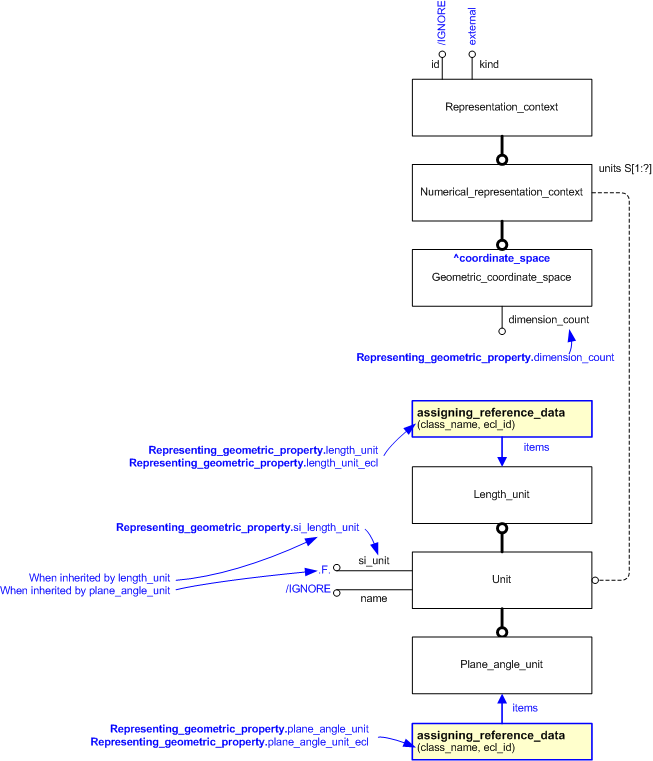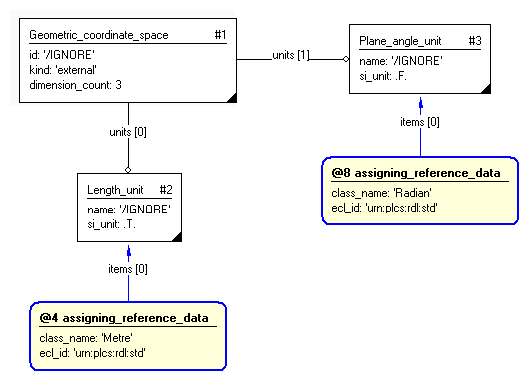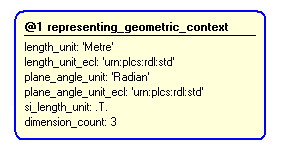Template:— representing_geometric_context (rep_geom_cntx)
Capability:representing_properties_numerically |
Date: 2011/10/21 08:39:53
Revision: 1.2
|
![[warning:]](../../../../images/dex/warning.gif) Error T1: There is no template_proxy in the capability representing_properties_numerically for the template representing_geometric_context
Error T1: There is no template_proxy in the capability representing_properties_numerically for the template representing_geometric_context
This section specifies the template representing_geometric_context.
NOTE
The template has been defined in the context of the capability
representing_properties_numerically
which provides an overall description of the
relevant parts of the ISO 10303-239 information model and a description
of related templates.
NOTE
An explanation of a template and the associated instantiation path is
provided in the
Template overview
section.
This template describes how to represent a geometric context.
The EXPRESS-G diagram in
Figure
1
shows the templates and EXPRESS entities that are required
to represent the template
"representing_geometric_context".
The text highlighted in blue shows the template parameters.
Figure 1 — An EXPRESS-G representation of the Information model for representing_geometric_context
The graphic for the template to be used in other EXPRESS-G diagrams
is shown in Figure
2
below.
Figure 2 — The graphical representation of the representing_geometric_context template
The following input parameters are defined for this template:
The following classes and their sub-classes can be used:
The identifier of the
External_class_library
that holds the definition of the class referenced by the parameter @length_unit.
The following classes and their sub-classes can be used:
The identifier of the
External_class_library
that holds the definition of the class referenced by the parameter @plane_angle_unit.
Value should be set to true if the unit is a SI base unit defined by ISO, i.e.
kilogram (kg) for Mass,
second (s) for Time,
metre (m) for Displacement,
ampere (A) for Electrical current,
kelvin (K) for Temperature,
mole (mol) for Amount of substance, and
candela (cd) for Luminous intensity. If this is not the case it should be set to false.
Note that the representation of true and false depends on exchange format. In Part 11 (a STEP file) true is
represented by the string ".T.", and false by ".F.", while in Part 28 (XML) they are represented by text strings
"true"
and "false".
The number of dimensions (2 or 3) of the geometric context.
The following reference parameters are defined for this template:
%^target = $representing_geometric_context.coordinate_space%
The instantiation path shown below specifies the entities that are to be
instantiated by the template.
A description of templates and the syntax for the instantiation path is
provided in the
Templates Help/Information section.
The following entities are instantiated with attributes as specified:
The instance diagram in Figure
3
shows an example of the EXPRESS entities and templates that are instantiated by the template:
/representing_geometric_context(length_unit='Metre', length_unit_ecl='urn:plcs:rdl:std', plane_angle_unit='Radian', plane_angle_unit_ecl='urn:plcs:rdl:std', si_length_unit='true', dimension_count='3')/
(an illustration of the consolidated representing_geometric_context template is shown in
Figure
4 below.)
Figure 3 — Entities instantiated by representing_geometric_context template
The instance diagram in
Figure
4
shows the graphic symbol for the template that is to be
used in other instance diagrams. The example template is:
/representing_geometric_context(length_unit='Metre', length_unit_ecl='urn:plcs:rdl:std', plane_angle_unit='Radian', plane_angle_unit_ecl='urn:plcs:rdl:std', si_length_unit='true', dimension_count='3')/
Figure 4 — Instantiation of representing_geometric_context template
Characterizations
No common characterizations of the template
representing_geometric_context
have been identified. However, the ISO 10303-239 EXPRESS model
may enable other assignments to the entities instantiated by the template.




